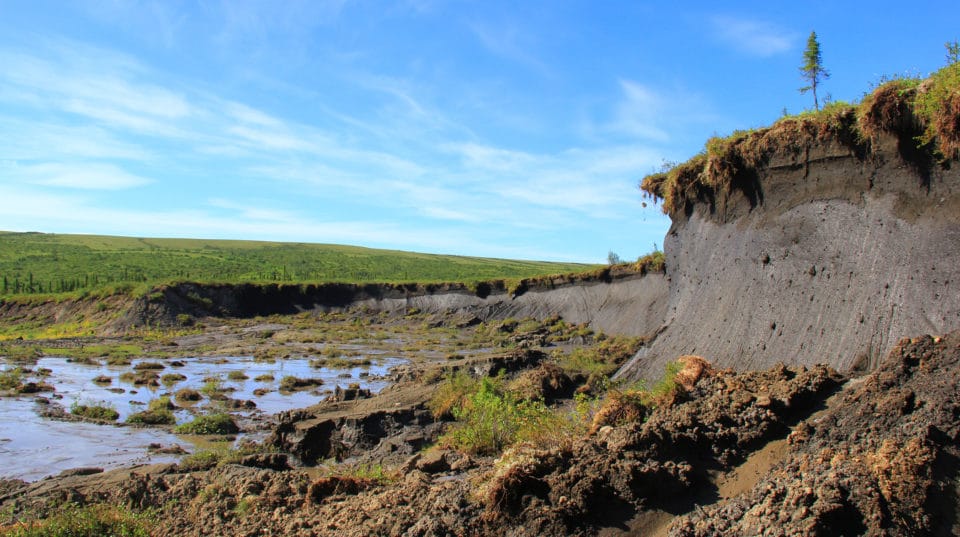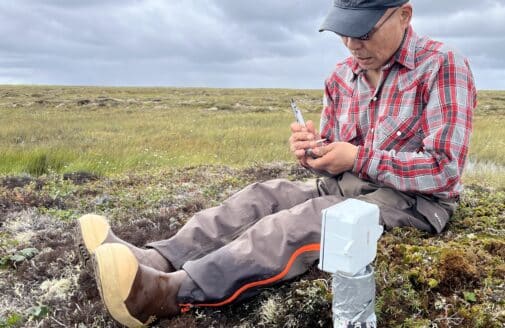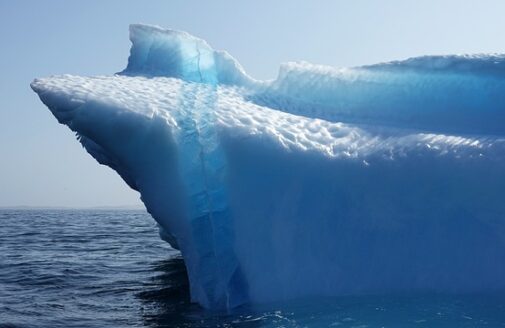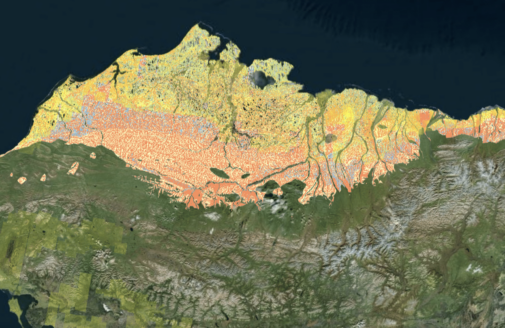Impacts of permafrost thaw and wildfires on global carbon budgets

Permafrost thaw slumping. / photo by Scott Zolkos
Key Points
- The Arctic is experiencing the greatest increase in average air surface temperatures globally.
- As the Arctic warms, permafrost (frozen soil) is thawing, and wildfires are increasing in severity and frequency, accelerating the thaw. These hazards will significantly increase carbon emissions and impact global climate, as permafrost contains approximately twice as much carbon as the atmosphere.
- Permafrost thaw emissions, especially from abrupt and fire-induced thaw, are rarely included in climate models and therefore not typically considered in mitigation decision making.
- Therefore, permafrost carbon emissions need to be accounted for in international decision-making regarding mitigation in the Paris Accord. To do this, we recommend increased engagement by international bodies and for the United States and other countries to adjust for Nationally Determined Contributions (NDCs) and raise awareness of permafrost emissions.

Woodwell scientist standing in front of permafrost.
photo by Beck Tachihara
Permafrost thaw and wildfires
The Arctic atmosphere has already warmed more than 2°C above pre-industrial levels. Climate change is dramatically altering the Arctic, and two of the most impactful changes are on permafrost and wildfires.
- Permafrost is ground that has been frozen for at least two consecutive years. Permafrost underlies much of the high latitudes and 24% of the total Northern Hemisphere land area. It stores vast amounts of carbon, roughly twice as much as in the atmosphere. As the Arctic warms, permafrost thaws, resulting in previously stored carbon being released into the atmosphere.
- Wildfire frequency and severity have increased across the Arctic in recent decades. This change is due to more severe droughts and fire weather, greater lightning frequency, longer fire seasons, and earlier snow melt.
Thawing permafrost (coupled with wildfires) accelerates climate change as a result of carbon dioxide and methane emissions, resulting in a self-enforcing positive feedback loop. These changes will not only damage socio-economic and cultural infrastructures but also will reduce the global carbon budget, the amount of carbon that can be released without overshooting temperature targets (1.5°C and 2°C) set under the Paris Accord.

A team of Woodwell scientists deploying a monitoring tower in Alaska’s Yukon-Kuskokwim Delta.
photo by Chris Linder
Implications for global carbon budgets
As permafrost thaws, carbon will be released into the atmosphere at unprecedented rates; current estimates range from 6 to 118 gigaton (Gt)C (22 to 432 Gt CO₂) under strong climate intervention scenarios and up to 150 Gt C (550 Gt CO₂) under weak climate intervention. Carbon loss can be exacerbated by abrupt thaw events and fire-induced thaw. Abrupt thaw results from melt-induced ground collapse that exposes deep permafrost to warmer air temperatures, leading to additional thawing. Fire-induced thaw is the result of wildfires burning the insulating layer of soil above permafrost, exposing it to warmer ambient air temperatures and accelerating thaw. Fire also releases carbon through the direct combustion of vegetation and organic matter in the soil.
Although permafrost thaw will have significant implications for global carbon budgets, it is not fully accounted for in most climate models used for policymaking. In the models that do include permafrost thaw, only gradual thaw is estimated and not abrupt or fire-induced thaw.
Estimates from the Intergovernmental Panel on Climate Change (IPCC) found that the global carbon budget without permafrost carbon emissions allows for 340 to 1000 Gt additional CO₂ equivalent (CO₂-e) to be emitted while still remaining below 2°C, and 290 to 440 Gt CO₂-e for 1.5°C. However, even without considering permafrost carbon emissions, IPCC acknowledges that it is likely we will overshoot the 1.5°C. Therefore, it is essential to accurately quantify, account, and include permafrost carbon emissions in climate models and decision making.
Recommendations
As more countries submit updated NDCs under the Paris Accord ahead of COP26, it is imperative to account for permafrost carbon emissions to avoid overshooting temperature targets. To do this, global assessments like the five-year Global Stocktakes and the IPCC Seventh Assessment Report should consider and include permafrost carbon emissions. This will allow countries, such as the United States, to appropriately adjust their NDCs.
Further, the United States can be a leader by integrating permafrost science into policy domestically and internationally, engaging other countries to do the same. International bodies, such as the UNFCCC and Arctic Council, should raise awareness of permafrost thaw and the impacts of their emissions.
Further Reading








